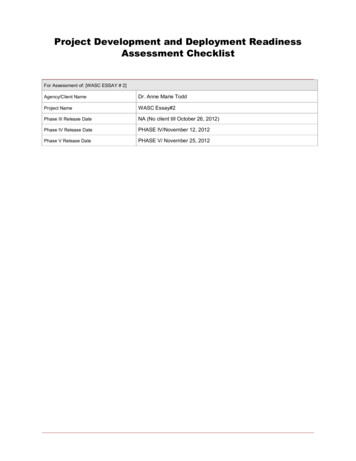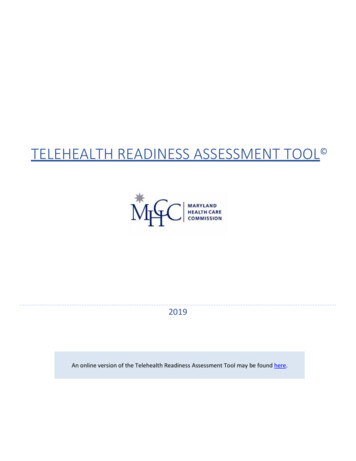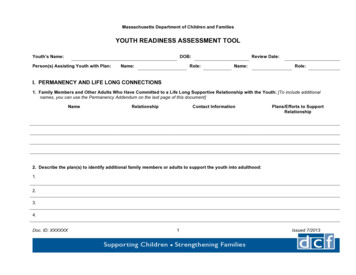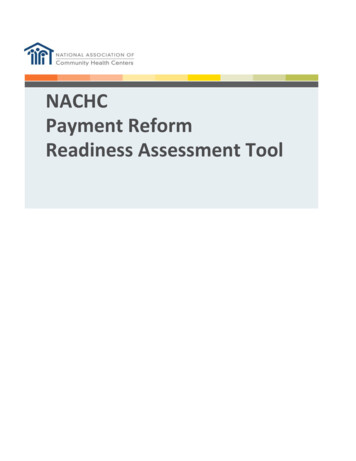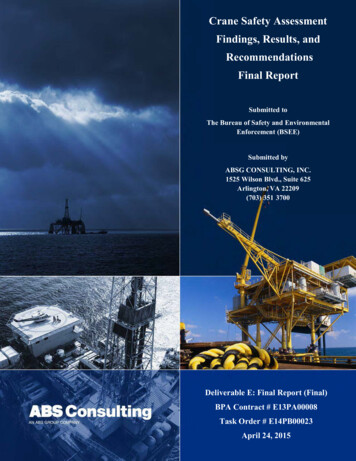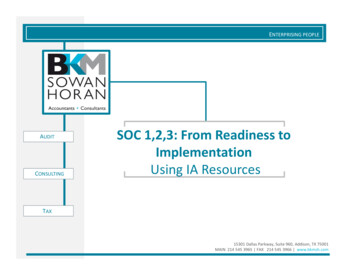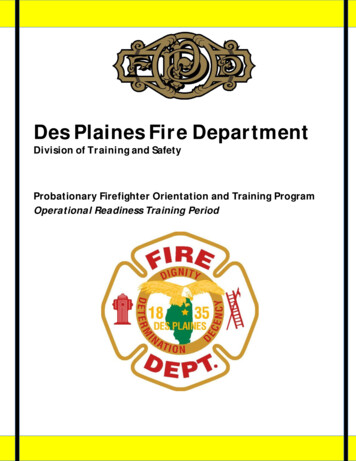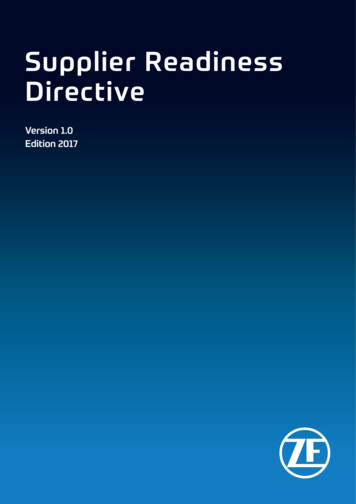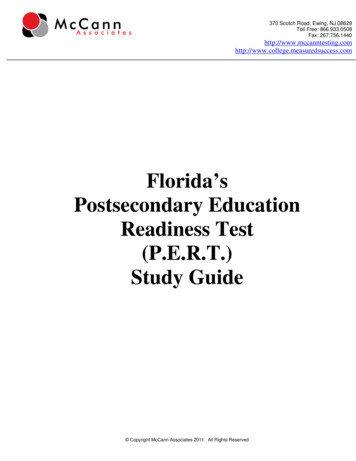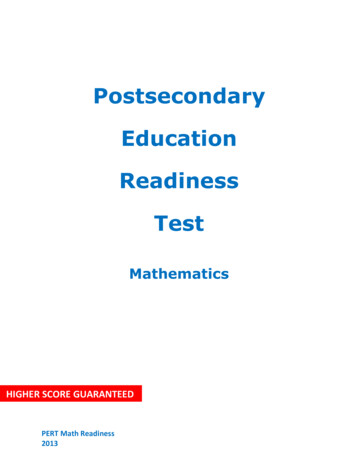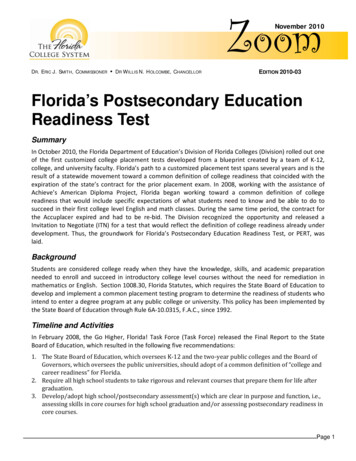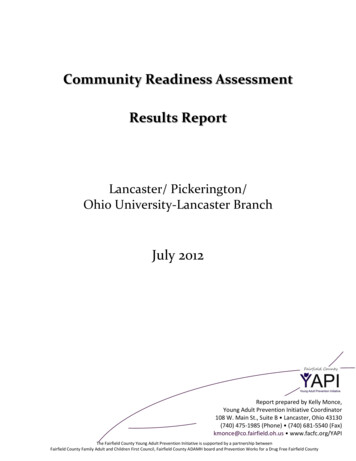
Transcription
Community Readiness AssessmentResults ReportLancaster/ Pickerington/Ohio University-Lancaster BranchJuly 2012Report prepared by Kelly Monce,Young Adult Prevention Initiative Coordinator108 W. Main St., Suite B Lancaster, Ohio 43130(740) 475-1985 (Phone) (740) 681-5540 (Fax)kmonce@co.fairfield.oh.us www.facfc.org/YAPIThe Fairfield County Young Adult Prevention Initiative is supported by a partnership betweenFairfield County Family Adult and Children First Council, Fairfield County ADAMH board and Prevention Works for a Drug Free Fairfield County
Community Readiness Assessment ReportBackground and InformationIn 2012 the Fairfield County Young Adult Prevention Initiative Coalition (YAPI) set out to perform a CommunityNeeds Assessment; a process which involved an analysis of the prescription drug problem in our community.The following Community Readiness Assessment Report is one piece of that Community Needs Assessment.It is important to note that for the purposes of our grant we have focused on three separate “communities”within Fairfield County; Lancaster, Pickerington and Ohio University Lancaster/Pickerington RegionalCampuses. This Report includes a separate assessment for each of these communities.The Fairfield County Young Adult Prevention Initiative utilized a free resource called the Community ReadinessModel created by the Colorado State University Tri- Ethnic Center for Prevention Research. For moreinformation or a copy of this model tyReadiness home.htmWhat is the Tri- Ethnic Community Readiness Model?The Community Readiness Model is an innovative method for assessing the level of readiness of a communityto develop and implement prevention and other intervention efforts.It defines 9 Stages of Community Readiness ranging from “no awareness” of the problem to “high level ofcommunity ownership” in response to the issue. . A complete list of the Stages of Community Readiness andexplanation of each stage can be found in the resource index at the end of this report.The Community Readiness Model was developed by the Tri-Ethnic Center for Prevention Research at ColoradoState University after much research and testing in communities. Its validity and reliability have beendemonstrated in many communities and with many issues.The Community Readiness Model identifies specific characteristics related to different levels of problemawareness and readiness for change. It is:- A step-by-step system for developing an effective prevention strategy. It gives a clear map of theprevention/intervention journey.- Issue-specific, community- specific, culturally specific and most important, measurable.The process for using the Community Readiness Model includes:1. Identifying the issue. In our case, the issue identified was “prescription drug misuse”.2. Defining “community.” In our case we defined three communities: Lancaster, Pickerington, andOU-L/P3. Conducting “key respondent” interviews. YAPI Coordinator Kelly Monce conducted the interviewsin all three communities.4. Scoring the interviews to determine the readiness level. YAPI Coalition Members Toni Ashton andPatti Waits independently scored each interview. YAPI Coordinator Kelly Monce then calculatedthe scores in order to determine the readiness level.2
Community Readiness Assessment ReportWhat is a key respondent and what are the key respondent interviews?Key respondents are individuals who are knowledgeable about the community, but not necessarily a leader ordecision-maker. They are involved in community affairs and know what is going on. By using a cross section ofindividuals, a more complete and accurate measure of the level of readiness for this issue in the communitycan be obtained.Key respondent interviews involve approximately 35-40 questions that are adapted to the community and theissue being addressed. Four to six key respondents are interviewed for about 30-60 minutes. The questionsasked provide information about six dimensions of the community readiness for the targeted issues.Interviewers transcribe the interviewee responses for the scoring process.What are the six dimensions of community readiness?Community readiness is multi-dimensional - six dimensions. The six dimensions of community readinessinclude the following key factors that influence a community’s preparedness to take action on an issue:1.2.3.4.5.6.Community EffortsCommunity Knowledge of the EffortsLeadershipCommunity ClimateCommunity Knowledge About the IssueResources Related to the IssueA community can be at somewhat different stages on each of the different dimensions; this is where thediagnostic aspect is determined. All dimensions are used to obtain a final community readiness score for theparticular issue being addressed. However, the individual dimensions are more telling when making thedecision where and how to develop your strategies. (A complete list and explanation of each dimension can befound in the Resource Index at the end of this report).ScoringInterviews are scored one at a time by at least two scorers following specific instructions and guidelines givento the scorers. Based upon statements and references in the interviews that refer to specific dimensions, foreach interview each dimension receives a score from 1-9 according to a scale for that particular dimension.The scorers then come together and agree on the scores of each dimension for each interview. Scores arethen averaged across interviews for each dimension, and the final score is the average across the sixdimensions. This final score gives the specific stage of readiness for this issue in the community.3
Community Readiness Assessment ReportCommunity: LancasterResultsCombined Scores: For each interview, the two scorers discussed their individual scores and then agreed on asingle score. This is the COMBINED SCORE.Interviews#1#2#3#4#5#6Total(A) Community Efforts(B) Community Knowledge of theEfforts(C) 35.5(D) Community Climate(E) Community Knowledge Aboutthe Issue(F) Resources Related to the alculated Scores: calculations were done by using the combined score TOTAL in the table above and dividingby the number of interviews conducted. The calculated scores are then added together.Community Climate (D)Community KnowledgeAbout the Issue (E)Resources Related tothe Issue (F)Average OverallCommunity ReadinessScoreStage Score for IndividualDimensions- Lancaster4.175.924.54.084.8Stage ScoreCommunity Efforts (A)Community Knowledgeof the Efforts (B)Leadership l Stage of Readiness: Taking the total calculated score and dividing by 6 (the number of dimensions).Then using the list of stages below match the result with a stage of readiness, rounding down instead of up asspecified in the instructions.Total Calculated Score 4.99, Stage 4 Preplanning4
Community Readiness Assessment ReportUsing the Assessment to Develop Strategies:With the information from this assessment, strategies can begin to be developed that will be appropriate foreach community. The first to look at in determining where to start with strategies is the distribution of scoresacross the dimensions, are they all about the same? Are some lower than others?To move ahead, readiness on all dimensions must be at about the same level- so if one or more dimensionshave lower scores than the others, efforts should be focused on strategies that will increase thecommunity’s readiness on that dimension or those dimension first. The intensity level of intervention orstrategy should be consistent with, or lower than, the stage score for that dimension. To be successful, anyeffort toward making change within a community must begin with strategies appropriate to its stage ofreadiness.In the Lancaster Community, the lowest scores are related to: Community Knowledge of the Efforts,Community Climate, Community Knowledge of the Issue, and Resources Related to the Issue; in these fourdimensions the scores are in Stage 4 - Preplanning. As we begin planning for implementation, it is importantthat we look at those dimensions and their corresponding stage of readiness and use the combination ofinformation to develop our strategic plan. In this case, initial efforts should focus on raising awareness withconcrete ideas to combat prescription drug misuse and should include: raising awareness about the causes of prescription drug misuse, the consequences, and how it impactsthe community;increasing the awareness of local efforts to prevent prescription drug misuse and their effectivenessamong community members;Helping to mold the prevailing attitude in the community to reflect responsibility and empowermentaround the prevention of prescription drug misuse; and increasing the amount of local resourcesavailable to support the prevention of prescription drug misuse.5
Community Readiness Assessment ReportCommunity: PickeringtonResultsCombined Scores: For each interview, the two scorers discussed their individual scores and then agreed on asingle score. This is the COMBINED SCORE.Interviews#1#2#3#4#5Total(A) Community Efforts(B) Community Knowledge of theEfforts(C) .5(D) Community Climate(E) Community Knowledge Aboutthe Issue(F) Resources Related to the 13.5Calculated Scores: calculations were done by using the combined score TOTAL in the table above and dividingby the number of interviews conducted. The calculated scores are then added together.(D) Community Climate(E) CommunityKnowledge About theIssue(F) Resources Relatedto the IssueAverage OverallCommunity ReadinessScore53.74.13.32.92.74Stage Score(A) Community Efforts(B) CommunityKnowledge of the Efforts(C) LeadershipStage Score for IndividualDimensions- verall Stage of Readiness: Taking the Total calculated score and dividing by 6 (the number of dimensions).Then using the list of stages below match the result with a stage of readiness, rounding down instead of up asspecified in the instructions.Total Calculated Score 3.52, Stage 3 Vague Awareness6
Community Readiness Assessment ReportUsing the Assessment to Develop Strategies:With the information from this assessment, strategies can begin to be developed that will be appropriate foreach community. The first to look at in determining where to start with strategies is the distribution of scoresacross the dimensions, are they all about the same? Are some lower than others?To move ahead, readiness on all dimensions must be at about the same level- so if one or more dimensionshave lower scores than the others, efforts should be focused on strategies that will increase thecommunity’s readiness on that dimension or those dimension first. The intensity level of intervention orstrategy should be consistent with, or lower than, the stage score for that dimension. To be successful, anyeffort toward making change within a community must begin with strategies appropriate to its stage ofreadiness.In the Pickerington Community, the lowest scores are related to: Community Knowledge About the Issue andResources Related to the Issue; in these two dimensions the scores are in Stage 2- Denial/Resistance. As webegin planning for implementation, it is important that we look at those dimensions and their correspondingstage of readiness and use the combination of information to develop our strategic plan. In this case, initialefforts should focus on raising awareness that the prescription drug misuse exists in this community andshould include: Raising awareness about the causes of prescription drug misuse, the consequences, and how it impactsthe community; andIncreasing the local resources such as people, time, money and space available to support the effortsto address the issue of prescription drug misuse in the community.7
Community Readiness Assessment ReportCommunity: Ohio University- Lancaster/ Pickerington BranchResultsCombined Scores: For each interview, the two scorers discussed their individual scores and then agreed on asingle score. This is the COMBINED SCORE.Interviews#1#2#3#4Total(A) Community Efforts(B) Community Knowledge ofthe Efforts(C) Leadership42.531.511323.51.510433111(D) Community Climate(E) Community KnowledgeAbout the Issue(F) Resources Related to lated Scores: calculations were done by using the combined score TOTAL in the table above and dividingby the number of interviews conducted. The calculated scores are then added together.(D) Community Climate(E) CommunityKnowledge About theIssue(F) Resources Relatedto the IssueAverage OverallCommunity ReadinessScoreStage Score for IndividualDimensions- OU-L/P2.52.75Stage Score(A) Community Efforts(B) CommunityKnowledge of the Efforts(C) 2.32.22.12ABCDEFDimensions15.39Overall Stage of Readiness: Taking the Total calculated score and dividing by 6 (the number of dimensions).Then using the list of stages below match the result with a stage of readiness, rounding down instead of up asspecified in the instructions.Total Calculated Score 2.56, Stage 2 Denial/Resistance8
Community Readiness Assessment ReportUsing the Assessment to Develop Strategies:With the information from this assessment, strategies can begin to be developed that will be appropriate foreach community. The first to look at in determining where to start with strategies is the distribution of scoresacross the dimensions, are they all about the same? Are some lower than others?To move ahead, readiness on all dimensions must be at about the same level- so if one or more dimensionshave lower scores than the others, efforts should be focused on strategies that will increase thecommunity’s readiness on that dimension or those dimension first. The intensity level of intervention orstrategy should be consistent with, or lower than, the stage score for that dimension. To be successful, anyeffort toward making change within a community must begin with strategies appropriate to its stage ofreadiness.In the Ohio University-Lancaster and Pickerington Branch community scores at the same stage for alldimensions, Stage 2 - Denial/Resistance; therefore strategies in this community should focus on increasing thecommunity’s overall readiness to address prescription drug misuse. Initial strategies should focus on raisingawareness that the issue of prescription drug misuse exists in this community and should concentrate onincreasing each of the dimensions of readiness in relation to the issue.9
Community Readiness Assessment ReportResource IndexDocuments in this index are copied directly from Community Readiness: A Handbook forSuccessful Change, developed by the Colorado State University Tri-Ethnic Center forPrevention Research.10
Community Readiness Assessment Report11
Community Readiness Assessment ReportStages of Readiness12
Community Readiness Assessment Report13
Community Readiness Assessment Report14
Community Readiness Assessment Report15
Community Readiness Assessment Report16
Community Readiness Assessment Report17
Community Readiness Assessment Report18
within Fairfield County; Lancaster, Pickerington and Ohio University Lancaster/Pickerington Regional Campuses. This Report includes a separate assessment for each of these communities. The Fairfield County Young Adult Prevention Initiativ
